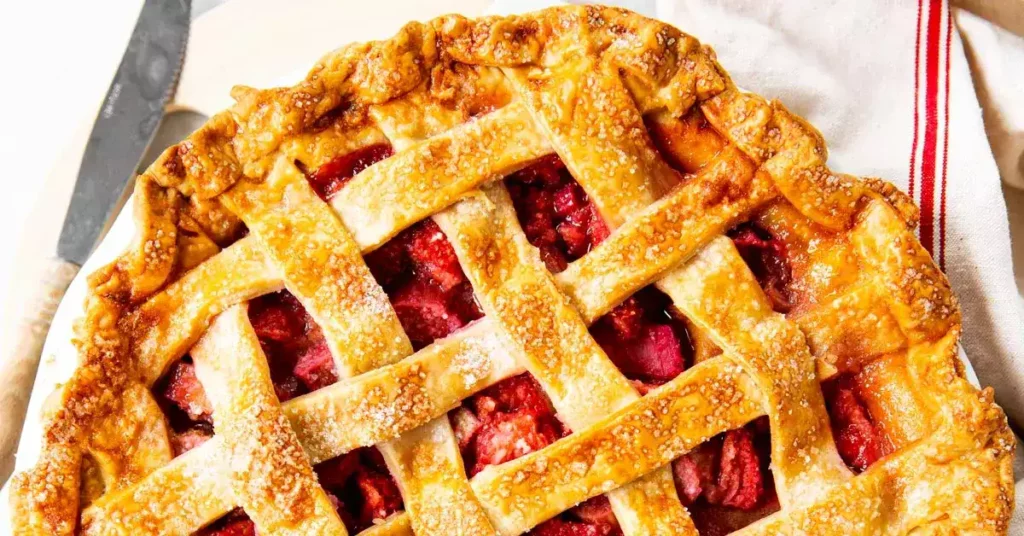Rhubarb pie is a beloved Newfoundland classic, bringing a perfect balance of tart and sweet to your table. This traditional dessert celebrates the vibrant, tangy flavor of rhubarb, making it a favorite for generations. Whether you’re new to baking or a seasoned pro, this guide will help you create a delicious rhubarb pie that captures the essence of Newfoundland’s culinary heritage.
In this guide, we’ll show you how to make the perfect rhubarb pie from scratch. The process is straightforward and rewarding, starting with a flaky, buttery crust that forms the base of this delightful dessert. We’ll walk you through each step, ensuring that your crust turns out just right golden and crisp, yet tender.
The star of the pie is, of course, the rhubarb filling. We’ll teach you how to prepare the rhubarb, blending it with just the right amount of sugar to balance its natural tartness. You’ll end up with a filling that’s bursting with flavor and has the perfect consistency.
Rhubarb pie is ideal for any occasion, from family gatherings to casual weeknight desserts. It’s a wonderful way to showcase the fresh, seasonal produce Newfoundland is known for. So, grab your apron and let’s get baking! With our easy-to-follow guide, you’ll be serving up a delicious, homemade rhubarb pie in no time, delighting friends and family with a taste of Newfoundland tradition.

Recipe:
- Preparation Time: 20-40 minutes
- Cooking Time: 45-55 minutes
- One double-crust 9-incb Pie
Pastry
- 5 1/2 cups flour, all-purpose
- 2 teaspoons salt
- 1 pound lard
- 1 tablespoon vinegar
- 1 egg, lightly beaten
- water
Pastry yields 3 9-incb double-crust Pies or 6 pie shells.
Unused pastry may be stored in refrigerator for 2-3 days or frozen.
Filling
- 4 cups fresh rhubarb (or frozen, thawed), cut in 1/2-inch pieces
- 1-1 1/2 cups sugar
- 3 tablespoons quick-cooking tapioca
- 1/4 teaspoon salt
- 1 tablespoon butter
Instructions
- Preheat oven to 4250F. Mix together flour and salt. Cut in lard with a pastry blender, or 2 knives, until mixture resembles coarse breadcrumbs.
- In a 1-cup measure, combine vinegar and egg. Add water to make 1 cup. Gradually stir liquid into dry ingredients but do not press mixture together. Add only enough liquid to make dough cling together. The amount will vary.
- Gather into ball and divide into 6 portions. Reserve 2 portions for rhubarb pie and refrigerate for 10 minutes while preparing filling. (Wrap unused portions and refrigerate until required or freeze.)
- Mix together rhubarb, sugar, tapioca and salt.
- Take 2/3 of dough and pat into circle. Roll out pastry, keeping circular shape, until half-inch larger than pie plate. Place loosely in 9-inch pie plate and trim even with rim. (Do not stretch the pastry).
- Roll out remaining pastry for top crust, making it inch larger than pie pan. If preferred, pastry may be cut in strips for lattice crust.
- Fill bottom crust with pie filling; dot with butter. Wet edge of bottom pastry to ensure 2 crusts seal. Cover with top pastry. Fold edge of top pastry under edge of bottom pastry. Flute edges together with thumb and forefinger.
- For whole crust, cut 2 or 3 slashes in centre of to allow steam to escape. Brush pastry with cold and sprinkle lightly with sugar (optional).
- Place pie in oven at 425F for 15-20 minutes, or until pastry is golden. Reduce heat to 350F and continue baking 30-40 minutes or until rhubarb is tender.
Newfoundland Historic Fact: Newfoundland’s Role in the Transatlantic Cable
In 1858, Newfoundland played a key role in connecting the Old World to the New with the successful laying of the first transatlantic telegraph cable. The cable ran from Valentia Island, Ireland, to Heart’s Content, Newfoundland. This technological marvel revolutionized communication, allowing messages to be sent across the ocean in minutes instead of weeks. Heart’s Content became a hub of activity, with engineers and workers maintaining the cable station. The successful transmission of the first message was celebrated on both sides of the Atlantic, marking a new era in global communication.


